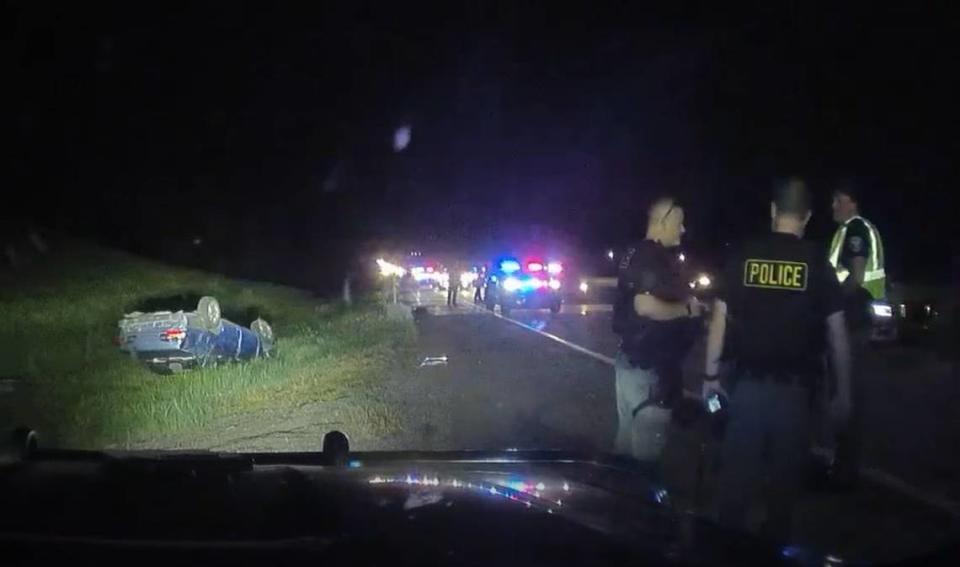Fatal crash in police chase doesn’t count, Kansas says — because it was on purpose
When a Bonner Springs police officer began chasing a man in June 2021 for an expired license plate, speeds on Interstate 70 escalated to 100 mph.
Then the officer intentionally hit the car to bring the chase to an end, a maneuver called a tactical vehicle intervention or TVI.
The driver, Darrell Vincent, of Kansas City, Kansas, was ejected and killed.
In an odd loophole, Vincent’s death is not counted in statewide or federal statistics on police chases because the officer purposely struck his car.
That officials choose not to include injuries or deaths caused by deliberate actions by police is one example of how police chases are not reliably counted by state or federal authorities.
“I think that’s wrong because it was a chase,” said Darrius Vincent, Darrell Vincent’s son. “It cost him his life and I just don’t think that was a good thing. It was a very bad thing.”

National experts recognize that pursuits are inherently dangerous and recommend restricting them to drivers suspected of committing violent felonies who present an imminent threat to the public. During a monthslong investigation, The Star found that police engage in dangerous high-speed chases every day around the metro, often for the most trivial offenses like license tag infractions, which have led to crashes, injuries and deaths.
Though data is incomplete, experts say enough is known to show that chases are a serious public safety concern. According to the National Highway Traffic Safety Administration or NHTSA, 525 people died in police chases in 2021, the most recent year data was available. That included 12 people in Missouri and six in Kansas, although the Kansas Department of Transportation’s data showed seven fatalities.
Unreliable data
Data on police pursuits is far from complete and not mandated by any federal agency.
While NHTSA collects information about fatal chases, submitting annual numbers is voluntary, according to a September report on pursuits by the Police Executive Research Forum.
“One of the real challenges is we don’t know the full extent of this problem,” said PERF’s executive director, Chuck Wexler. “So getting more accurate information would certainly be helpful. But I’ll tell you what I know now. I have enough data that’s reported to NHTSA to know this is a national problem.”
At a statewide level, the Missouri State Highway Patrol, the Missouri Department of Public Safety and the Missouri Department of Transportation do not collect comprehensive information on police chases.
The Kansas Department of Transportation compiles data on police chases that end in injuries, fatalities or property damage. As of Nov. 28, the state had recorded 179 crashes resulting in five deaths, 95 injuries and 111 instances of property damage last year. In the past decade, 53 people have died and more than 1,300 have been injured.
But it does not include crashes that occur on private property or that cause less than $1,000 in damage, said Steve Hale, a spokesman for KDOT.
In addition to data being incomplete, statewide and national reporting requirements exclude cases of “legal intervention,” as was the case in Darrell Vincent’s death when police used the TVI.
“If the officer used any type of intervention the case in not reported to us, so the chase or crash would not count,” said Theresa Havenstein, a crash data analyst with KDOT. “They would probably have complete(d) something on their end but would not turn it into us.”
Chases, crashes and deaths like Vincent’s are not counted in annual reports on police pursuits, according to KDOT and NHTSA. Both agencies said they follow guidelines defined in the American National Standard, which do not include TVIs because they are considered legal intervention.
Wexler said “that makes no sense to me.”
KDOT did not respond to further questions about their data collection in cases of legal intervention.

‘Give it a shot’
Around 9:30 p.m. on June 19, 2021, a Bonner Springs police officer began to follow a 1996 Geo sedan. A chase ensued over a temporary license plate violation, according to a police report.
Dashboard camera footage shows the driver signal he is turning right and the officer turns on his emergency lights. The driver pulls into a QuikTrip, loops around one of the gas pumps and leaves the parking lot as the officer activates his sirens. The driver turns onto K-7 Highway and several vehicles move to the right hand lane.
The chase continues for several minutes onto eastbound Interstate 70. At one point, a passenger in the Geo sticks his hands out the window.
About four minutes and 15 seconds into the chase, a supervisor is heard giving permission for a TVI, a controversial maneuver intended to force a driver into spinning out and coming to a stop.
The officer reports that speeds are at 90 mph and there is traffic, but once past the other vehicles, he will “give it a shot.”
Speeds climb to 100 mph.
The Geo is in the left-hand lane when the officer, who is in the middle lane, bumps its back passenger side. The Geo immediately veers across the two highway lanes as it screeches and goes out of view of the dashboard camera.
The officer turns around and the vehicle is illuminated by headlights. It is upside down with its tires spinning in the air.
The passenger slowly crawls on his knees through the crushed vehicle and exits through the back window.
Vincent was ejected. He died at the scene.
Chases in Bonner Springs
The Bonner Springs Police Department said the chase went against its policy, which had been updated five days prior, and warned officers using a TVI above 45 mph makes it “more unpredictable.”
PERF’s report on police pursuits, which sets out several best practices related to chases, said speed, passengers and traffic conditions should be factors when an officer considers using a TVI.
While experts have not settled on a maximum speed for using a TVI, the report said practice at a federal police training facility takes place at 25 to 35 mph.
Bonner Springs Police Maj. Chris Nicholson said officers receive an hour of classroom training on how to perform a TVI and legal aspects of using the tactic. Then they spend the rest of the day behind the wheel with an instructor and then in the driver’s seat.
“Students perform three low-speed TVIs and three high-speed TVIs and have to show success in those practicals to pass,” Nicholson said. “Although not required, we recertify annually doing the above all over again.”
The Star collected its own data and found that the Bonner Springs Police Department engages in a disproportionate number of chases. In 2022, officers gave chase 47 times in the town of about 7,700 people. Kansas City, Missouri, which has more than a half million people, engaged in 98 chases.
Bonner Springs Police Chief William Naff did not respond to questions about the department’s high rate of chases or the crash that killed Vincent.
Vincent’s son, Darrius Vincent, noted that his father was killed the weekend of Father’s Day.
Darrell Vincent grew up in Kansas City, Kansas, the youngest of six children. For a time, he lived in Germany before returning to the area. He had a passion for music and cooking, and was known to be a jokester.
Earlier in 2021, Darrius Vincent had been hospitalized. His father came to visit him. He usually wasn’t overly emotional, Darrius Vincent said, but he was crying.
“He just hated to see me in bad health,” Darrius Vincent said. It was the last time he would see his dad alive.
While Darrius Vincent understands that “laws are laws,” he said of police chases, “not everything is life and death.”
“The cost is way too high.”
How we reported this
After two innocent bystanders were killed in a police chase in March in Independence, Star reporters began looking into law enforcement pursuits in the Kansas City area. Over the next nine months, the reporters filed more than 140 public records requests with more than 60 local law enforcement agencies across the metro. They gathered police pursuit policies and documents recording chases, crashes and injuries over a period of five years.
Reporters also obtained investigative case files from serious and fatal wrecks, including dashboard camera recordings. They reviewed court documents from lawsuits and legal settlements. In all, the team examined more than 4,500 pages of documents, allowing them to identify patterns in police pursuits and practices in the metro.
They also spoke with more than 60 people, including innocent bystanders who were injured in police chases, families of victims killed in pursuits, police officials, attorneys and academics who have been studying the topic for decades. They interviewed a person in prison serving a sentence for killing four people in a crash during a police chase in 2018.
The project is published in a series of eight stories, with videos of interviews and crashes, as well as infographics showing the scope of police pursuits in the metro.
Credits
Katie Moore, Glenn E. Rice and Bill Lukitsch | Reporters
Emily Curiel and Nick Wagner | Visuals
Monty Davis | Video Editing
Neil Nakahodo | Illustrations & Design
David Newcomb | Development & Design


